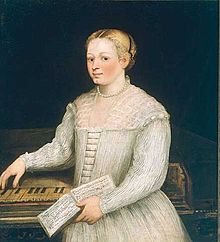利用者:Omletham/sandbox
 |
ここはOmlethamさんの利用者サンドボックスです。編集を試したり下書きを置いておいたりするための場所であり、百科事典の記事ではありません。ただし、公開の場ですので、許諾されていない文章の転載はご遠慮ください。
登録利用者は自分用の利用者サンドボックスを作成できます(サンドボックスを作成する、解説)。 その他のサンドボックス: 共用サンドボックス | モジュールサンドボックス 記事がある程度できあがったら、編集方針を確認して、新規ページを作成しましょう。 |

マリエッタ・ロブスティ (1560? – 1590) はルネサンス期のヴェネツィアの画家。ティントレットの娘でしばしばティントレッタと呼ばれた。
生涯
[編集]現在知られているマリエッタ・ロブスティの一次資料は、1642年初版のカルロ・リドルフィの『ティントレットの生涯』であるが、1584年のラファエッロ・ボルギーニの『イル・リポーゾ(Il Riposo della Pitura e della Scultura)』に簡単に触れられている[1]。 ボルギーニによれば1555年生まれであるが[1] 、カルロ・リドルフィは1560年に生まれたとしている[2]。
マリエッタ・ロブスティはおそらく1560年生まれで、30歳のときに出産中に死亡した。生涯をヴェネツィアで過ごした。彼女は画家ヤコポ・ロブスティの長女で、父親に由来してティントレッタと呼ばれていた。 (translated as "little dyer girl", after Jacopo’s father’s occupation as a tintore, or dyer). そのため彼女はマリエッタ・ロブスティ、マリエッタ・ティントレット、ティントレッタとして知られている。彼女には3人の兄弟と4人の姉妹がいた[3]。
当時の慣習では、女性は家庭の中にいるものであり、芸術品の創作や売買という公の場に出ることは歓迎されていなかったので、ロブスティや彼女の同時代の女性は、芸術家である父親や兄弟を通して芸術界と接していた[4]。ロブスティの画家としての修行は父の工房へ徒弟として奉仕することであり、そこで彼女はおそらく父の作品の背景や群衆を担当した。背景や群衆は当時の画家工房で徒弟の役割分担とされていた[5]。 Robusti's artistic training consisted of serving an apprenticeship in the collaborative environment of her father’s workshop, where she probably contributed to her father’s paintings with backgrounds and figure blocking, as was the usual distribution of labor in painting workshops of the time.[5] ロブスティはほかの女性の職人よりも社会的、経済的に自立していたわけではなかったが、彼女にはかなりの追随者がおり、芸術における女性らしさをThough Robusti's social and economic autonomy was no greater than other artisan women she had quite a following, changing the ideals of femininity within the arts. 彼女の死後、カルロ・リドルフィは同時代で最も著名な女性の一人だったとし、父と同じ技能を持っていたとした。After her death, Carlo Ridolfi stated she was one of the most illustrious women of her time, having the same manner of skill as her father while displaying "sentimental femininity, a womanly grace that is strained and resolute." 父の工房で働いているとき、ロブスティは祭壇画制作のアシスタントを務めていたと言われているが、彼女の業績は父の名前に 。While Robusti worked in her father's studio it was also said she worked on altarpieces as an assistant but her achievements were buried under the name of her father. 彼女の死後、ティントレットによる作品制作数が減少したのは、熟練したアシスタントの不在のためというよりは、娘を失った悲しみによるものとされている[3]。After her death the decline in work produced by Tintoretto was ascribed to grief for his daughter, rather than the loss of a skillful assistant.[3]
死後、マリエッタ・ロブスティはロマン主義の画家にとってのミューズになった。レオン・コニエは1846年に『死んだ娘を描くティントレット』を、エレウテリオ・パリアーノは1861年に『ティントレットと娘』を制作した。制作者から男性のカウンターパートとへと変化した女性画家の比喩は、The trope of women artists being transformed from creators to for male counterparts made her a motif for male creativity, displaying a dying muse of quietly suffering femininity.[3]
Evidenceはロブスティが祭壇画や教会装飾といった大規模な宗教作品の注文を受けておらず、もっぱら肖像画家であったということを示している[6]。
リドルフィはロブスティと父ティントレットとの密接な関係を詳細に記述している。彼女は父のひざ元で学んだだけでなく、子供のころは父についてどこにでも行けるように少年の恰好をしていた。マクシミリアン2世とスペイン王フェリペ2世は彼女を宮中画家として招こうとしたが、父親が彼女と別れるのが耐えられないとして招待を断った。1578年には、父は、彼女が常に自分のそばで生活するよう、ヴェネツィアの宝石職人で銀細工師でもあったヤコポ・アウグスタと婚姻させた。ヤコポもまた、Jacopo also had Marietta instructed in singing and playing the harpsichord, clavichord, and lute.
彼女の死は記録されていないが1590年とされ、遺体はヴェネツィアのサンタ・マリア・デル・オルト教会に埋葬された。
Attributions and assessment
[編集]
マリエッタ・ロブスティに明らかに帰属される絵画は、彼女の『自画像』(1580年頃、フィレンツェ、ウフィツィ美術館所蔵)である。この自画像は、スピネットの前で楽譜を手に持ちポーズを取るマリエッタを描いたもので、楽譜はフィリップ・ヴェルドロのマドリガーレ『Madonna per voi ardo』とされている。It has been postulated that the inclusion of this text, whose opening lines are "My Lady, I burn with love for you and you do not believe it"から始まる一説 このことから、この自画像は男性の鑑賞者、おそらくマリエッタの夫のために制作されたことを示唆している[7]。
そのほかのに彼女に帰属している作品は、1920年までロブスティの作であることが明らかになっていなかった『老人と少年』 ( 1585年頃、美術史美術館、ウィーン)、『ortrait of Ottavio Strada (1567年から68年頃、アムステルダム市立美術館、アムステルダム)、聖母子を描いた2枚の小品(制作年不明、クリーブランド美術館、オハイオ)、MRとサインのある『二人の男性の肖像 (Gemäldegalerie Alte Meister, Dresden)』
Other attributions include: Old Man and a Boy (c. 1585; Kunsthistorisches Museum, Vienna), which was long considered one of Tintoretto's finest portraits and was not revealed to be Robusti's until 1920;[3] Portrait of Ottavio Strada (c. 1567-68; Stedelijk Museum, Amsterdam); and two small paintings of the Virgin and Child (dates unknown, Cleveland Museum of Art, Ohio). Portrait of Two Men (Gemäldegalerie Alte Meister, Dresden), signed "MR", is thought to be Marietta Robusti's only surviving signed work.[6]
Notes
[編集]- ^ a b Eric Newton, Tintoretto. (London: Longmans, Green and Co., 1952), 62.
- ^ Carlo Ridolfi, Life of Tintoretto, trans. Catherine and Robert Enggass (University Park, PA: Pennsylvania State University Press, 1984), 99.
- ^ a b c d e Women, Art, and Society
- ^ H.T. Niceley, "A Door Ajar: The Professional Position of Women Artists", Art Education 45, no. 2 (Mar., 1992): 6-13.
- ^ a b Newton, Tintoretto, 66.
- ^ a b Grove Art Online, s.v. “Marietta Robusti.” Available from Grove Art, George Mason University Lib.[1](accessed 10 February 2008).
- ^ Katherine A. McIver, "Lavinia Fontana's 'Self-Portrait Making Music'," Woman's Art Journal 19, no. 1 (Spring-Summer 1998): 3-8.
References
[編集]- McIver, Katherine A. "Lavinia Fontana's 'Self-Portrait Making Music'," Woman's Art Journal 19, no. 1 (Spring-Summer 1998): 3-8.
- Newton, Eric. Tintoretto. London: Longmans, Green and Co., 1952.
- Niceley, H.T. "A Door Ajar: The Professional Position of Women Artists," Art Education 45, no. 2 (Mar., 1992): 6-13.
- Ridolfi, Carlo. The Life of Tintoretto and of his children Domenico and Marietta. Translated by Catherine Enggass and Robert Enggass. University Park, PA: Pennsylvania State University Press, 1984.
- Wasmer, Marc-Joachim. Die Künstlertochter Marietta Robusti, genannt Tintoretta, in: "Unser Kopf ist rund, damit das Denken die Richtung wechseln kann." Festschrift für Franz Zelger, ed. Matthias Wohlgemut, in collaboration with Marc Fehlmann, Zurich 2001, 463–494
External links
[編集]- Self Portrait at Scholars Resource (thumbnail)
- Portrait of Ottavio Strada at Web Gallery of Art
- Marietta Robusti in Dictionary of Painters and Engravers: Biographical and Critical by Michael Bryan
- Women Artists in History by Wendy Russ
- La Renaissance- WebMuseum, Paris by Nicolas Pioch
